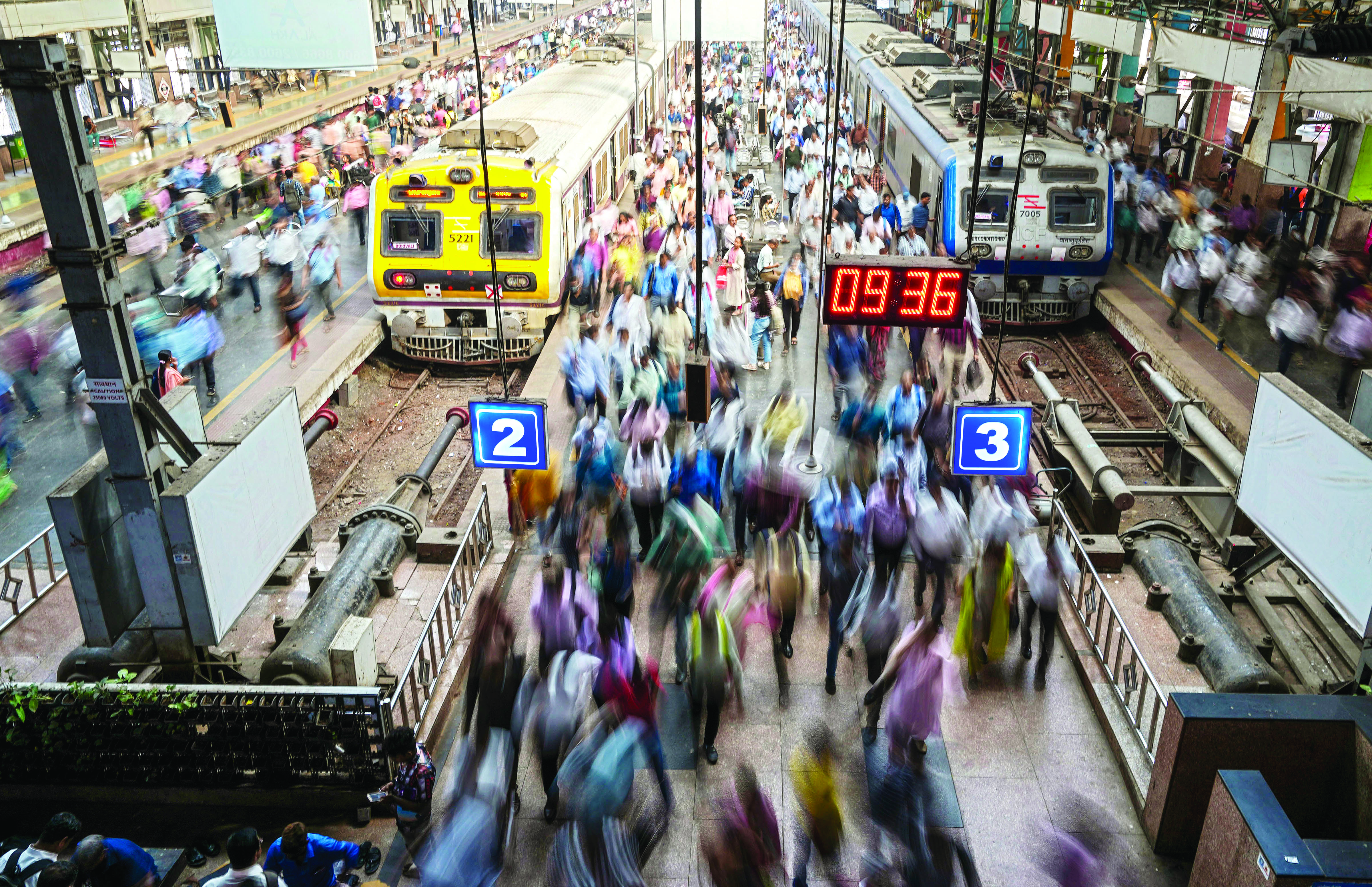Bolstering the quality of populace
Neither a booming population is guarantee for economic growth nor a dip in it spells a doomsday situation; India needs to invest in education, healthcare, and basic infrastructure to compete with China

At the end of 2022, the population of mainland China was 1.411 billion people, a decrease of 850,000 over the previous year. Compared to this, in 2022, India had a population of 1.4066 billion, just trailing China’s 1.4485 billion. In 2022, the global population has hit eight billion. One billion people were added during the last 12 years. Deutsche Welle reported that India contributed the most towards the recent billion, to the tune of 177 million people, while China added 73 million people during the same period.
China’s GDP had grown three per cent in 2022. Though that figure would mark one of the slowest periods of growth in decades, it was still higher than the predicted growth rate during stringent ‘zero COVID’ restrictions. At a recent press conference, Kang Yi, head of the National Bureau of Statistics, claimed, China’s overall labor supply still exceeded demand, and people should not worry about the population decline. Nonetheless researchers believe the lower population growth rate could mean higher labor costs in China because of a smaller pool of available workers.
Besides China, another Asian economic powerhouse — Japan — is also facing the same problem of population shrinkage. In 2022, Japan is estimated to have had fewer than 800,000 births compared to the previous year. Japan’s prime minister says his country is on the brink of not being able to function as a society because of its falling birth rate. BBC reported that falling birth rates are driven by a range of factors, including rising living costs, more women in education and work, as well as greater access to contraception, leading to women choosing to have fewer children.
China’s dipping population
In 2022, China saw more deaths than births. Last year’s birth rate was 6.77 births per 1,000 people, down from a rate of 7.52 births in 2021, marking the lowest birth-rate on record. The country also logged its highest death rate since 1976, registering 7.37 deaths per 1,000 people compared with a rate of 7.18 deaths in 2021, reported The Guardian. Official data shows that last year, 10.41 million people died while 9.56 million were born. This is the first time that has happened since the great famine in 1959-1961. In 1980, the Chinese government formally instituted the one-child policy, legally restricting families from having more than one baby. The policy was intended to further limit China’s population growth and help stimulate an economic boom. Though in 2015, China ended the one-child policy and began allowing married couples to have two children and expanded the allowance again in 2021, permitting up to three kids; this new attempt to reverse the course and encourage families to have more children haven’t worked. Besides, the COVID pandemic and strict ‘zero COVID’ policy may be responsible for such a sudden fall in population. Analysts fear that the shrinkage could complicate China’s plans for continued economic expansion, reported NPR.
China is approaching a ‘moderately aging’ scenario, in which 20 per cent of its population is aged 60 and older. By 2035, that percentage is expected to rise to 30 per cent, or more than 400 million people, reported Global Times. However, Table 1, which shows an age-specific projection of population distribution (in millions) of China and India by 2030, doesn’t indicate any major disadvantage for China due to the demographic shift. Moreover, a totalitarian state like China will be able to change, if required, the population distribution to its advantage during the next decade. Besides, people with adequate training and proper healthcare support remain equally, if not more, productive even at the age of 70. The production pattern is fast changing across the globe. Senior people are getting increasingly absorbed in relatively less gruelling jobs. So, the aging population should not be a serious problem for China in the near future.
Nonetheless, analysts expect that higher cost of production will push foreign companies having manufacturing facilities in China to look for other alternative destinations. China plus One (C+1) is a global business strategy in which companies avoid investing only in China and diversify their businesses to alternative destinations. Officials and companies in Japan and the United States had begun mulling over a diversification strategy away from China as early as 2008. However, it was only towards the end of the last decade, when US-China trade tensions were at their peak, that C+1 gained steam as an alternative strategy for transnational corporations (TNCs).
Population explosion in India
India is projected to surpass China as the world’s most populous country in 2023. According to the United Nations Population Fund (UNFPA), by 2050, India is projected to have a population of 1.67 billion, higher than the 1.32 billion people forecast for China by the middle of the century. In addition to this, the UN report said that China’s contribution to the next billion will be negative. More than half of the projected global population increase by 2050 is expected to be concentrated in eight countries, one of which is India, reported Deutsche Welle. However, data suggest India’s annual population growth has averaged 1.2 per cent since 2011, compared with 1.7 per cent in the previous decade. As per a report by Reuters, further slowing can be expected as India’s total fertility rate (TFR) — children per woman — fell to two in the latest assessment period, for 2019-2021, from 3.4 in 1992-93.
A comparison of the present age distribution of the population between India and China (refer to table 2) reveals that till 2021, China had a higher share of the working age population (15-64) compared to India. The table also reveals, during the last decade, while the share of the Chinese working population has declined from 74.4 per cent to 68.3 per cent, the corresponding share of India has increased from 64.33 per cent to 67.51 per cent.
Untapped cheap labour
It is argued that a large number of the population helps in two ways: (i) it stimulates domestic demand; (ii) it supplies labour at a relatively cheaper rate. In the case of India, the first advantage gets nullified due to extreme inequality of wealth distribution. The latest Oxfam report suggests that the bottom 50 per cent of the population has only three per cent of the nation’s wealth, and the top one per cent has grabbed over 40 per cent of the wealth. As this small section of the super-rich spends their wealth in expensive foreign goods, effective domestic demand doesn’t improve unless a large amount of wealth is transferred to the masses. Second, large numbers of unskilled, semi-skilled laborers are not a good bet to attract investment. If it was so, the ‘Make in India for the World’ would have attracted huge investment by now. It may be presumed that The China Plus One strategy would not be effective unless India develops an ecosystem that offers a decent manufacturing environment that, even remotely, compares with China, reported Madhyam.org.
It may be mentioned that in late July 2022, a grouping of 18 economies, including India, the US, and the European Union, unveiled a roadmap for establishing a collective supply chain that would be resilient in the long term. The roadmap also included steps to counter
supply chain dependencies and vulnerabilities. This can also be viewed as a part of overall China Plus One strategy.
India’s China Plus One strategy can be seen as an extension of its ‘Make in India’ initiative which began in September 2014. The ‘Make in India’ initiative aims to encourage businesses all over the world to invest and manufacture their products in India. The main goal of the initiative is to turn India into a manufacturing powerhouse similar to China. Under this initiative, the manufacturing sector was estimated to contribute 25 per cent of the national GDP by 2022, up from barely 15 per cent in 2014. The National Manufacturing Policy now aims to increase the manufacturing sector’s share of GDP to 25 per cent by 2025, instead of 2022, as set previously.
Speaking at the closing session of the DPIIT’s webinar on ‘Make in India for the World’, held in March 2022, Piyush Goyal, Minister of Commerce and Industry, acknowledged this disappointment with the programme and asked the industry to explore opportunities to increase the contribution of the manufacturing sector to 25 per cent of GDP and set up 10 R&D labs or innovation centres to become a global leader in technology.
If one analyses the data in table 3 on Human Development Index (HDI), it would be clear why India has failed to leverage its huge labour force though China has successfully used it to its advantage. The HDI is a summary measure for assessing long-term progress in three basic dimensions of human development: a long and healthy life, access to knowledge and a decent standard of living.
China’s HDI value for 2021 is 0.768 which has put the country in the high human development category, at 79 out of 191 countries and territories. Between 1990 and 2021, China’s HDI value changed from 0.484 to 0.768, a change of 58.7 per cent. Between 1990 and 2021, China’s life expectancy at birth changed by 10.2 years, mean years of schooling changed by 3.5 years, and expected years of schooling changed by 5.6 years. Also, China’s GNI per capita changed by about 1092.0 per cent between 1990 and 2021. Compared to this, India’s HDI value for 2021 was 0.633 — which put the country in the Medium human development category — at 132 out of 191 countries and territories. Between 1990 and 2021, India’s HDI value changed from 0.434 to 0.633, a change of 45.9 per cent, and between 1990 and 2021, India’s life expectancy at birth changed by 8.6 years, mean years of schooling changed by 3.9 years, and expected years of schooling changed by 3.9 years. India’s GNI per capita has changed by about 268.1 per cent between 1990 and 2021.
A study by Sing and Liu (2016), which made a comparative analysis of health and socioeconomic data for China and India, from 1960 to 2011, found that health improvements have been more rapid and widespread in China than in India during that period. The authors concluded that India’s less favorable health profile compared to China was largely attributable to its higher rates of mortality from communicable diseases and maternal and perinatal conditions. Further health gains could be achieved by reducing social inequality, greater investments in human development and health services, and by prevention and control of chronic-disease risks such as hypertension, smoking, obesity, and physical inactivity.
The difference in the quality of human capital has made all the difference between China’s and India’s growth story. Figures in Table 4 on intellectual property reveal how China is ahead of India in filing patent, trademark, and industrial design applications. Moreover, unlike in China, in the case of patent applications, non-resident applicants far outnumber the resident applicants in India.
Conclusion
The sheer population is a misleading parameter to evaluate as an asset or liability to a nation. To attract and retain quality foreign capital, India must invest in education, healthcare, and basic infrastructure. It is a well-established fact that educated and skilled workers will attract quality capital in the high-end sector where knowledge spillover would be higher. The success of China’s development model, in attracting global manufacturers to its shore, during the last forty-odd years is a case in point.
Views expressed are personal



